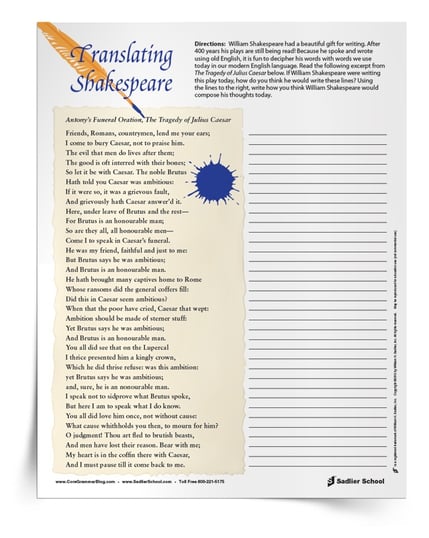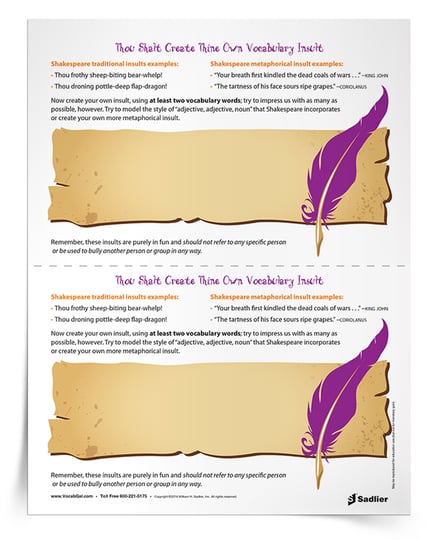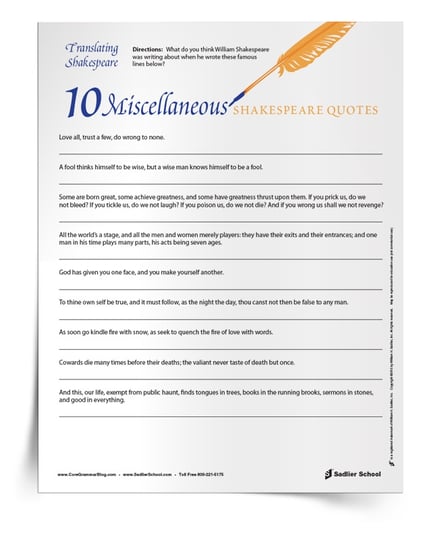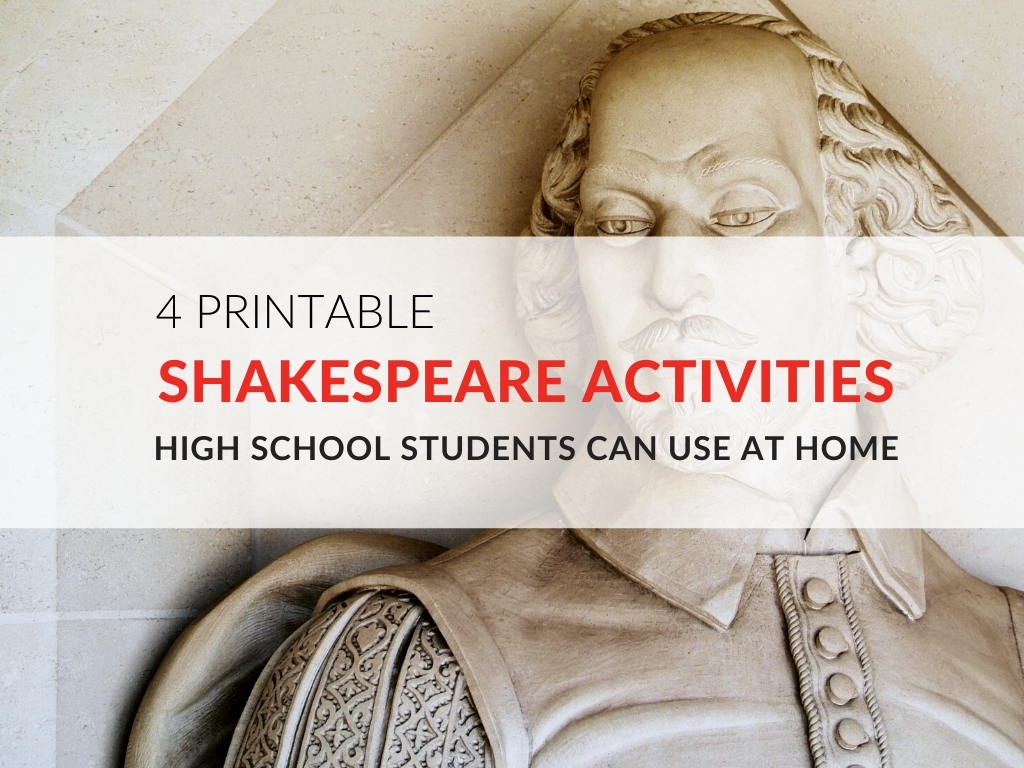April 16, 2024 CG Writing Lessons 9-12, ELA Resources - Activities, ELA Focus - Writing, ELA 9-12, ELA Seasonal - Spring, Core Grammar
4 Shakespeare Activities for High School Students
By: Tiffany Rehbein
High school students have the opportunity to learn a great deal by studying Shakespeare. Students enhance their vocabulary, study the human experience, learn about form and structure through sonnets, and learn about persuasion through character monologues. Here are 4 printable Shakespeare activities for high school students that can be completed in the classroom or at home!
Download the Translating Shakespeare Activities for high school students!
Why We Still Teach Shakespeare
Every year during the second semester, tenth-grade teachers at my school begin to teach William Shakespeare’s The Tragedy of Julius Caesar. Recently, a colleague and I were exchanging teaching ideas in our shared office space when a co-worker asked us, “Why do you still teach Shakespeare?”.
Although I wanted to reply “all’s well that ends well,” I instead outlined four key reasons to teach Shakespeare. My co-worker’s question is not so uncommon in many teaching situations, and the bottom line is: that Shakespeare is still relevant and necessary today. English teachers are in the business of stories, and Shakespeare was a great storyteller. Through his use of character and his illumination of the human condition, Shakespeare has enamored audiences for centuries. The most compelling argument to teach Shakespeare, however, is his crafty language.
Shakespeare Continues to Influence Students
Shakespeare’s phrases continue to influence students year after year. My favorite, because I teach The Tragedy of Julius Caesar in March, is “Beware the Ides of March.” Other popular phrases include:
-
What’s in a name?
-
Shall I compare thee to a summer’s day?
-
We are such the stuff as dreams are made on
-
To be, or not to be: that is the question
-
Wild goose chase
-
Off with his head
-
Seen better days
-
Off with his head
-
Good riddance
-
As luck would have it
-
Love is blind
-
Heart of gold
-
Knock, knock! Who's there?"
Shakespeare’s stories capture countless audiences because of the many forms his writing takes, including love stories, comedies, histories, adventures, tragedies, fairy tales, poetry, and melodramas. William Shakespeare lived from 1564–to 1616 and was born at Stratford-upon-Avon. He wrote 37 plays, the majority of which were comedies.
Some of his more famous comedies include As You Like It, The Merchant of Venice, and A Midsummer Night’s Dream; his best-known histories include Richard II, Henry V, and Richard III; and his more famous tragedies include Romeo and Juliet, Macbeth, and Hamlet.
Printable Shakespeare Activities for High School Students
Marc Antony’s funeral oration begins with some of the most memorable language: “Friends, Romans, Countrymen.” Antony’s speech is a great example for teaching persuasion. This activity addresses the following objectives: 1. analyze a speech for rhetorical devices and their purpose; 2. identify elements of persuasive techniques within a speech; and 3. apply elements of a persuasive speech and write in today’s language.

Students will need paper copies of the speech to annotate. First, students identify the speaker, message, and audience. This is the initial step in analyzing the speech. In the margin, students can draw a triangle, labeling one angle “Speaker,” one angle “Message,” and one angle “Audience.” Next to each point, students can answer the following questions:
-
Who is speaking?
-
Who is listening?
-
What values, beliefs, or ideas are being communicated?
Next, students identify the rhetorical devices. To do this, assign a highlighter color to a type of appeal (e.g., pink for logos, blue for pathos, yellow for ethos). Students highlight parts of the speech with the color that aligns with each type of appeal. In the margin, students write the purpose of that appeal. Teachers will have the chance to formatively assess the students during this activity by evaluating students’ highlights and writings.
To share ideas among students, teachers can facilitate discussions about the author’s purpose for using each persuasive technique. After the students have worked through the previous steps, they may be ready to apply their skills to writing.
The students at this point have spent some time identifying and analyzing Shakespeare’s persuasive techniques and rhetorical strategies. The next step is to paraphrase Antony’s speech in modern language, utilizing the same rhetorical moves. Hand out Translating Shakespeare, Antony’s Funeral Oration. On the sheet, students write how they think William Shakespeare would express his ideas today.
If you are teaching Hamlet, download Translating Shakespeare, Hamlet’s Soliloquy now!
Activity 3: Thou Shalt Create Thine Own Vocabulary Insult
A common fear among students regarding Shakespeare’s works is the difficult language presented in the plays. This fun activity—written and designed by our own Vocab Gal—will help students review vocabulary and while it leads them to become more comfortable with Shakespeare’s language.

To start, share with students some of your favorite Shakespearean insults. Check out one of the many websites devoted to generating Shakespearean insults. While sharing your favorite insults, discuss how Shakespeare created many of his insults—either using the "adjective, adjective, noun" formation or with a more metaphorical turn of phrase. This helps students create their own insults!
Next, instruct students to go through their vocabulary books and compile a list of insulting vocabulary words. This part of the Shakespeare lesson plan can be done in groups, individually, or as a class.
Finally, hand out a Thou Shalt Create Thine Own Vocabulary Insult worksheet to each student. On their vocabulary worksheet, students write down what they believe is their best Shakespeare-like insult. Once complete, students can share their vocabulary insult with the class or teachers can hang them on a classroom bulletin board!
Download the Thou Shalt Create Thine Own Vocabulary Insult Shakespeare lesson plan now!
Activity 4: Translating 10 Shakespearean Quotes
The language of Shakespeare has been alluded to throughout history, and is especially prevalent in pop culture in the form of songs, movies, and other pieces of literature. In honor of Shakespeare’s birthday in April, have students make educated guesses about what Shakespeare might have really been saying. This activity lets students practice with Shakespearean language and provides relevance as they translate his language into modern-day terms.
To introduce the activity, share with students some of your favorite Shakespeare quotes, such as those included earlier in this post. There are many websites devoted to Shakespeare and to his famous lines. As you share, tell students why those lines are important to you and what they mean to you. This prepares students for the activity itself.
Next, have students go through the play you are reading as a class and write lines they find important, poignant, or meaningful in some way. This can be done individually, in pairs, or small groups.
Finally, hand out a 10 Miscellaneous Shakespeare Quotes worksheet to each student. Have them read each line and write what they think William Shakespeare was meant when he wrote the lines.

In Summary
Shakespeare’s ability to tell a story is enhanced through his creative phrases and insults. Shakespeare’s compelling characters and his insight into the human condition—as evidenced by Antony’s funeral oration and by Hamlet’s soliloquy—keep students returning year after year to study his plays and poems. Shakespeare’s clever phrases are another reason that generation after generation of readers keep coming back for more.





